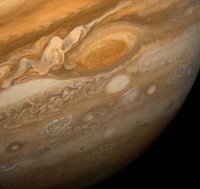Great Red Spot
|
|
The Great Red Spot is an anticyclonic storm on the planet Jupiter, 22° south of the equator; which has lasted at least 300 years. The storm is large enough to be visible through Earth-based telescopes. It was first observed either by Cassini or Hooke around 1665.
This dramatic view of Jupiter's Great Red Spot and its surroundings was obtained by Voyager 1 on February 25, 1979, when the spacecraft was 5.7 million miles (9.2 million kilometers) from Jupiter. Cloud details as small as 100 miles (160 kilometers) across can be seen here. The colorful, wavy cloud pattern to the left of the Red Spot is a region of extraordinarily complex and variable wave motion. To give a sense of Jupiter's scale, the white oval storm directly below the Great Red Spot is approximately the same diameter as Earth.
The oval object rotates counterclockwise, with a period of ~6 days. The Great Red Spot's dimensions are ~24–40,000 km × 12–14,000 km. It is large enough to contain two or three planets of Earth size. The cloudtops of this storm Great Red Spot are ~8 km above the surrounding cloudtops.
Jupiter_Great_Red_Spot_Animation.gif
Storms such as this are not uncommon within the atmospheres of gas giants. Jupiter also has white ovals and brown ovals, which are lesser unnamed storms. White ovals tend to consist of relatively cool clouds within the upper atmosphere. Brown ovals are warmer and located within the "normal cloud layer". Such storms can last hours or centuries.
It is not known exactly what causes the Great Red Spot's reddish color. Theories supported by laboratory experiments suppose that the colour may be caused by any of "complex organic molecules, red phosphorus, or yet another sulfur compound" [1] (http://www.space.com/reference/brit/jupiter/climate.html), but a consensus has yet to be reached.
The Great Red Spot is remarkably stable, having first been spotted over 300 years ago. Several factors may be responsible for its longevity, such as the fact that it never encounters solid surfaces over which to dissipate its energy and that its motion is driven by Jupiter's internal heat. Simulations suggest that the Spot tends to absorb smaller atmospheric disturbances.
At the start of 2004, the Great Red Spot is approximately half as large as it was 100 years ago. It is not known how long the Great Red Spot will last, or whether this is a result of normal fluctuations.
The Great Red Spot should not be confused with the Great Dark Spot, famously seen in the atmosphere of Neptune by Voyager 2 in 1989. The Great Dark Spot was an atmospheric hole, not a storm, and was no longer present as of 1994 (although another, similar spot had appeared farther to the north).
External links
- Jupiter simulations (http://www.gfdl.noaa.gov/~gw)
- Researcher predicts global climate change on Jupiter as giant planet's spots disappear (April 2004) (http://www.berkeley.edu/news/media/releases/2004/04/21_jupiter.shtml)de:Großer Roter Fleck
it:Grande Macchia Rossa nl:Grote Rode Vlek sl:Velika rdeča pega ca:La Gran Taca Vermella pl:Wielka Czerwona Plama pt:Grande Mancha Vermelha fr:Grande tache rouge

